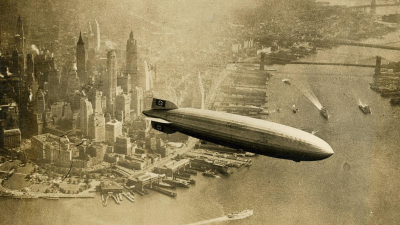What was the first successful airship built by Ferdinand von Zeppelin in 1900?

On July 2, 1900, the first directed flight of the LZ-1, a zeppelin airship, took place in Germany. The man behind it was Ferdinand Graf von Zeppelin, who pioneered the cause of building rigid dirigible airships, so much so that his surname is still popularly used as a generic name.
Aeroplanes are now the norm for air travel but there was a brief period early in the aeronautical history when airships or dirigibles were believed capable of playing a crucial role in aviation development. Large, controllable balloons propelled by an engine, airships are one of two types of lighter-than-air aircraft (the other one being well, balloons of course!)
Now relegated to aerial observations, advertising and other areas where staying aloft is more important than movement, airships come in three main types: the non-rigid airships or blimps, the semi-rigid airships, and the rigid airships, often called zeppelins. The last category is more popular as zeppelins because it was a German man called Ferdinand Graf von Zeppelin who conceived and developed the first rigid dirigible.
Born in Konstanz, Germany on July 8, 1938, Zeppelin studied at the University of Tubingen before entering the Prussian Army in 1858. He travelled to the U.S. during the American Civil War and acted as a military observer for the Union Army.
An idea is born
It was during this time, in 1863, when Zeppelin had the first of several balloon ascensions at St. Paul, Minnesota. While he was quick to realise the weakness of free balloons, their overdependence on winds and their uncontrollability, it was an experience that stayed with him through a lifetime.
By the 1870s, the idea of building a steerable airship had taken shape in Zeppelin's mind. So when he retired from the army with the rank of brigadier general, he decided to devote himself to building these airships.
Zeppelin toiled for a decade even though there were many naysayers. By 1900, he had built the first rigid-body airship consisting of a long, uniform cylinder with rounded ends. At 420 feet long and 38 feet in diameter, it had a hydrogen gas capacity of nearly 3,99,000 cubic feet.
Flies from a floating hangar
From a floating hangar on Lake Constance, Germany, the initial flight of LZ-1, the first zeppelin, took place on July 2, 1900. Days away from turning 62, Zeppelin had finally made progress with an idea that had been with him for decades.
While the demonstration wasn't entirely successful, the craft attained speeds of nearly 32 km/hour, enough to spark enthusiasm around zeppelins, get more donations, and have enough funding to keep the progress happening. Zeppelin tirelessly worked to make new and improved dirigibles and even created the first commercial passenger air service with them by 1910, but it wasn't until World War I that support from the government finally came in.
With most aeroplanes still in the development phase, the Germans perceived the advantages of zeppelin-type rigid airships, which could not only attain higher altitudes than aeroplanes of the time, but also remain airborne for nearly 100 hours. More than 100 zeppelins were employed by the Germans for military operations during World War I.
Hindenburg disaster
Zeppelin died in 1917, without seeing the heights that his zeppelins reached, and the tragedy that followed. The LZ-127 ‘Graf Zeppelin’ was launched in 1927 and it was one of the largest ever built. Having a length more than that of two-and-a-half football fields, it made a number of trans-Atlantic flights.
The LZ-129 ‘Hindenburg’ came about in 1936 and was touted to become the most famous zeppelin ever. Instead, tragedy struck and the ‘Hindenburg’ exploded and burned on May 6, 1937 at its mooring mast in New Jersey. (In case you were wondering, the Hindenburg Research investment company, which has constantly been in the news this year following their reports about the Adani Group, was named after this zeppelin.)
The Hindenburg disaster spelt doom for zeppelins as the remaining ones were also taken off service and dismantled. While safety concerns diminished their popularity, they had helped establish the principles of lighter-than-air aircraft and had even been among the first to provide commercial air travel.
Picture Credit : Google
